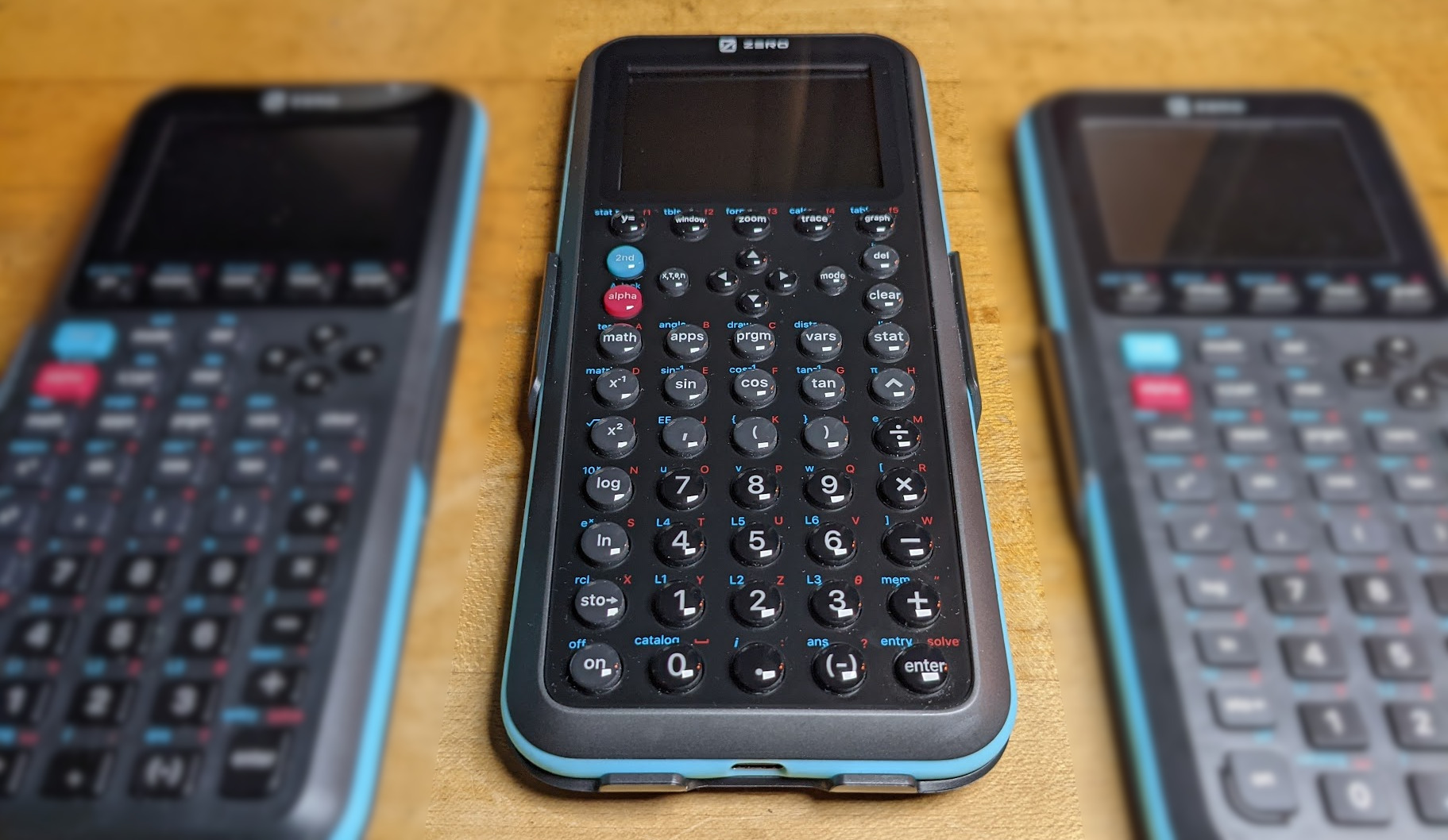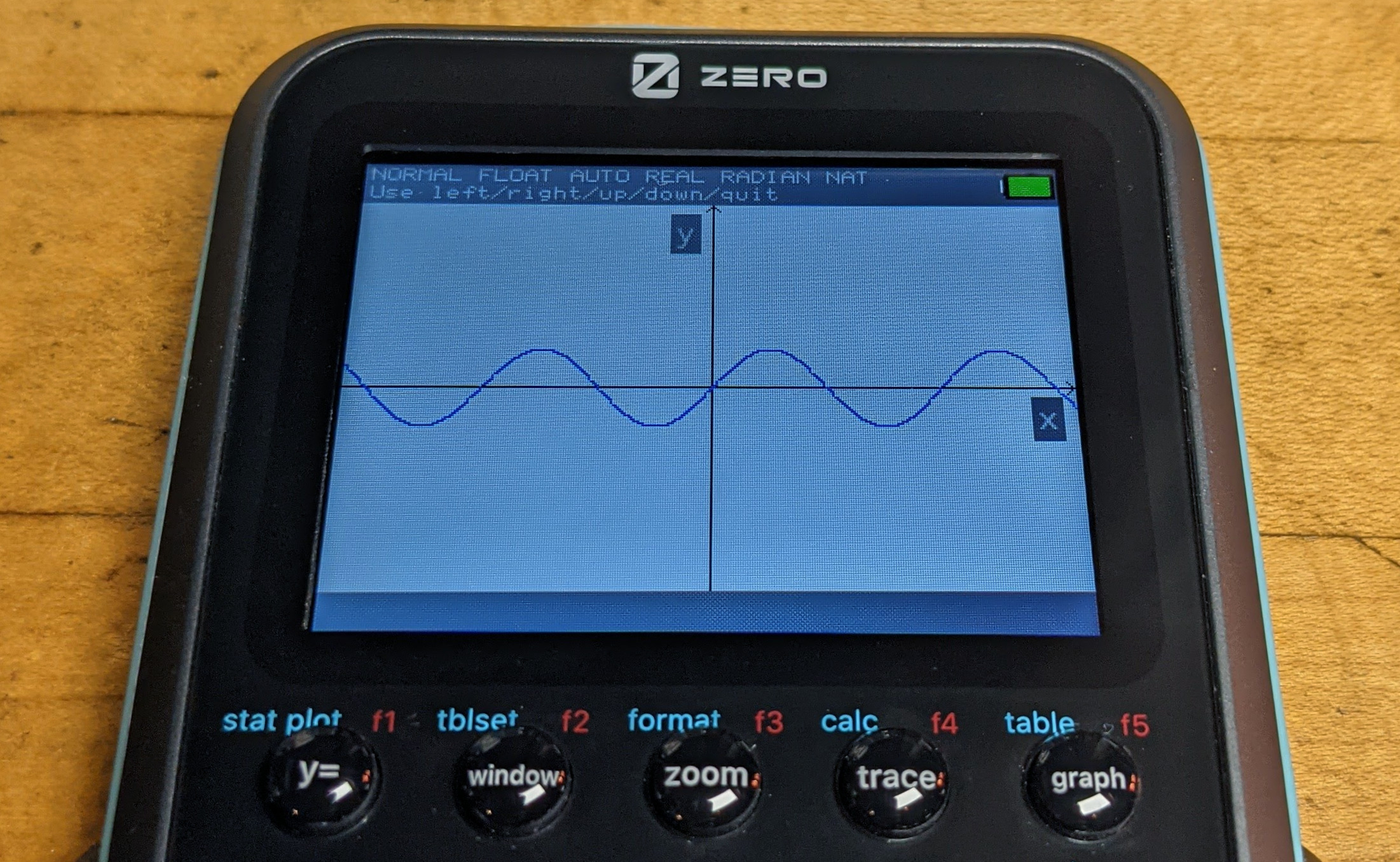When did you last lay eyes on a graphing calculator made by a company you've never even heard of before? In a few days, we'll go in-depth with a new calculator made by
Zero Calculators, joining the cohort of calculators made by Texas Instruments, Casio, HP, or newcomer NumWorks. Members of the community have been testing prototypes from this new company for almost two years, and it's a pleasure to finally be able to share a hands-on look at the latest version, currently called the "ZGC3".

The new Zero Calculators offering is aimed squarely at the TI-84 Plus CE user: while the current prototype no longer perfectly matches the keypad layout of Texas Instruments' popular calculator, it doesn't stray far, and navigating the operating system will be simple for the seasoned Texas Instruments calculator user. The calculator does many things right, including the speed of its graphing and programming language, while a lot of unpolished hardware corners and software bugs remain in this prototype. In a few days, we'll bring you a deep dive into this new calculator and give you the chance to judge for yourself if it's a calculator you want to include in your own classroom or collection.

Always interesting to see a newcomer in the market.
I hope they will succeed and it will create some kind of positive emulation to get new features.
I need to admit I am not a big fan of the rounded keys and the "glossy" effect of the keys/front plate, but I guess all the rework between ZGC3 and previous versions came from pressure from TI.
Let see what it brings and what can be expected from this hardware very soon.
Being based in France, I do not know if this machine will reach us or if it will remain exclusive to US market.
Why did they make the buttons circular?

To be honest, it looks underwhelming. Given the similarity to the TI-84 Plus CE, I am worried about its success.
slyVTT wrote:
Always interesting to see a newcomer in the market.
I hope they will succeed and it will create some kind of positive emulation to get new features.
I need to admit I am not a big fan of the rounded keys and the "glossy" effect of the keys/front plate, but I guess all the rework between ZGC3 and previous versions came from pressure from TI.
Indeed, that's my understanding. I haven't seen anything specific, but if I were TI's lawyers, I would have been pretty quick with a cease-and-desist for the ZGC1 and ZGC2.
Quote:
Let see what it brings and what can be expected from this hardware very soon.
Being based in France, I do not know if this machine will reach us or if it will remain exclusive to US market.
Good point! I haven't heard anything about language packs yet.
clevor wrote:
To be honest, it looks underwhelming. Given the similarity to the TI-84 Plus CE, I am worried about its success.
Makes sense. Personally, I'm not worried about its success from its superficial similarity to the CE, but as you'll see from our deep dive, there are a lot of rough corners yet to polish, including some fundamental problems with how it does math.
If you have any tests you'd like to see run or questions you want answered in our deep dive, let us know!
Do we know the architecture of the calculator's processor and what other hardware components it will include? And what language(s) it may support? Also do we know if they will be taking TI's approach and calling everything but the kitchen sink proprietary or will they be properly documenting their code entry points and exposing user access to stuff like interrupts and possible crypto hardware?
If they do this right, this may become an even more viable development platform than the CE, especially if TI chooses to continue to wage war on development for its calcs.
ACagliano wrote:
Do we know the architecture of the calculator's processor and what other hardware components it will include? And what language(s) it may support? Also do we know if they will be taking TI's approach and calling everything but the kitchen sink proprietary or will they be properly documenting their code entry points and exposing user access to stuff like interrupts and possible crypto hardware?
We'll definitely cover all of this, including disassembly photos, but the quick answer is a Gigadevice ARM CPU with 3MB of internal Flash and 256KB of SRAM, plus 64Mbit (8MB) external DRAM and 64Mbit (8MB) of external serial Flash. It has a non-TI BASIC language, and in theory MicroPython, although the implementation is extremely immature. We haven't yet found (or to my knowledge, investigated) how to run native code on it.
I'm assuming there's no CAS, but an exact math engine would be really nice.
arusher999 wrote:
I'm assuming there's no CAS, but an exact math engine would be really nice.
Assuming running native code is feasible, there would be quite some quick options to do that smoothly (GIAC / Khicas)
The hardware should be powerful enough to support this.
so basically, it's like the hp prime in that it can't run any sort of powerful code? Also, whats the battery life like in comparison to the ti 84 plus ce?
Calculatordream wrote:
so basically, it's like the hp prime in that it can't run any sort of powerful code? Also, whats the battery life like in comparison to the ti 84 plus ce?
The battery capacity is 2200mAh to the TI-84+CE's 1200mAh, but I haven't run it long enough to evaluate the battery life experimentally. Based on the discharge rate shown on the Mem screen (~70mA at my current screen brightness), the battery life would be up to 31 hours, but I don't have equipment hooked up to evaluate discharge rate running intensive calculations or programs.
The rounded buttons (and having the arrow keys in the middle) seem like a huge step back design-wise, the screen (and resolution) and overall shape and color scheme do look nice though. But without access to native code that's all a moot issue for me anyway.
Cool! Regarding native code is that meant to be a feature or is the plan just BASIC + Python for now?
That's a lot of RAM! Do you know what type of ARM CPU it is and frequency?
I would suspect that they will leave reverse-engineering and native programming at the hands of the community while warning to not touch anything related to the exam mode and light. Personally I am interested in the Basic language as I want to compare the execution speed compared to a rev-M+ CE.
tr1p1ea wrote:
Cool! Regarding native code is that meant to be a feature or is the plan just BASIC + Python for now?
That's a lot of RAM! Do you know what type of ARM CPU it is and frequency?
Like DJ said, I'm pretty sure the current plan is just BASIC and Python and then let the community figure out other stuff. Not officially blocked but also not directly supported, per se.
I believe that this is the processor that the latest prototype is using.
Quick question. Is the board in the proto with the square keys the same as the rounded one or at least the same foot print?
It's not the same - the pads for the keys moved, it has a different SoC, etc. It's about the same footprint, though; the case didn't change massively.
KermMartian wrote:
It's not the same - the pads for the keys moved, it has a different SoC, etc. It's about the same footprint, though; the case didn't change massively.
Ok thanks yea I forgot the keys moved  I was just curious.
I was just curious.
Makes sense. Board photos will be forthcoming.

Couldn't Zero just release an SDK, just like Texas Instruments did for the TI-83 Plus?







































